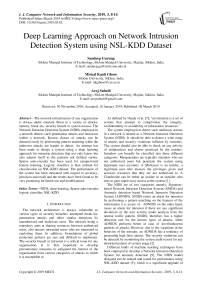Deep learning approach on network intrusion detection system using NSL-KDD dataset
Автор: Sandeep Gurung, Mirnal Kanti Ghose, Aroj Subedi
Журнал: International Journal of Computer Network and Information Security @ijcnis
Статья в выпуске: 3 vol.11, 2019 года.
Бесплатный доступ
The network infrastructure of any organization is always under constant threat to a variety of attacks; namely, break-ins, security breach or system misuse. The Network Intrusion Detection System (NIDS) employed in a network detects such penetration attacks and intrusions within a network. Known classes of attacks can be detected easily by performing pattern matching while the unknown attacks are harder to detect. An attempt has been made to design a system using a deep learning approach for intrusion detection that not only learns but also adjusts itself to the patterns not defined earlier. Sparse auto-encoder has been used for unsupervised feature learning. Logistic classifier is then utilized for classification on NSL-KDD dataset. The performance of the system has been measured with respect to accuracy, precision and recall and the results have been found to be very promising for future use and modifications.
NIDS, deep learning, Sparse auto-encoder, logistic classifier, NSL-KDD
Короткий адрес: https://sciup.org/15015671
IDR: 15015671 | DOI: 10.5815/ijcnis.2019.03.02
Список литературы Deep learning approach on network intrusion detection system using NSL-KDD dataset
- Behrouz A Forouzan, Debdeep Mukhopadhyay (2017), Cryptography and Network Security, (Third Edition), McGraw Hill Education (India) Private Limited.
- D. E. Denning, “An Intrusion Detection Model,” IEEE Transactions on Software Engineering, SE-13, pp. 222- 232, 1987.
- S. Revathi, Dr. A. Malathi, “A Detailed Analysis on NSL-KDD Dataset Using Various Machine Learning Techniques for Intrusion Detection”, International Journal of Engineering Research & Technology (IJERT), ISSN: 2278- 0181 Vol. 2 Issue 12, December - 2013.
- KDD Cup 1999 Data, Available on: http://kdd.ics.uci.edu/databases/kddcup99/kddcup99.html, August 2003.
- “Nsl-kdd data set for network-based intrusion detection systems.” Available on: http://nsl.cs.unb.ca/KDD/NSL- KDD.html, March 2009.
- Q. Niyaz, W. Sun, AY Javaid, and M. Alam, “A Deep Learning Approach for Network Intrusion Detection System” in Proceedings of the 9th EAI International Conference on Bio-inspired Information and Communications Technologies, ser. BICT’15. ICST, Brussels, Belgium, Belgium: ICST (Institute for Computer Sciences, Social-Informatics and Telecommunications Engineering), 2016, pp. 21–26. [Online]. Available: http://dx.doi.org/10.4108/eai. 3-12-2015.2262516.
- R. Heady, G. Luger, A. Maccabe, and M. Servilla, “The architecture of a network level intrusion detection system”, Technical report, Computer Science Department, University of New Mexico, August 1990.
- N. Shone, T. N. Ngoc, Vu D. Phai, “A Deep Learning Approach to Network Intrusion Detection”, IEEE Transactions on Emerging Topics in Computational Intelligence (Volume: 2, Issue: 1) Feb. 2018.
- Shyu, M-L., S-C. Chen, K. Sarinnapakorn, and LW. Chang, “A Novel Anomaly Detection Scheme Based on Principal Component Classifier”, ICDM Foundation and New Direction of Data Mining workshop, 03-1221.1-2312, 2003.
- K. Alrawashdeh and C. Purdy, “Toward an Online Anomaly Intrusion Detection System Based on Deep Learning,” in 2016 15th IEEE International Conference on Machine Learning and Applications (ICMLA). Anaheim, California, USA: IEEE, dec 2016, pp. 195–200.
- Chuanlong Yin, Yuefei Zhu, Jinlong Fei, Xinzheng He, “A Deep Learning Approach for Intrusion Detection Using Recurrent Neural Networks”.


